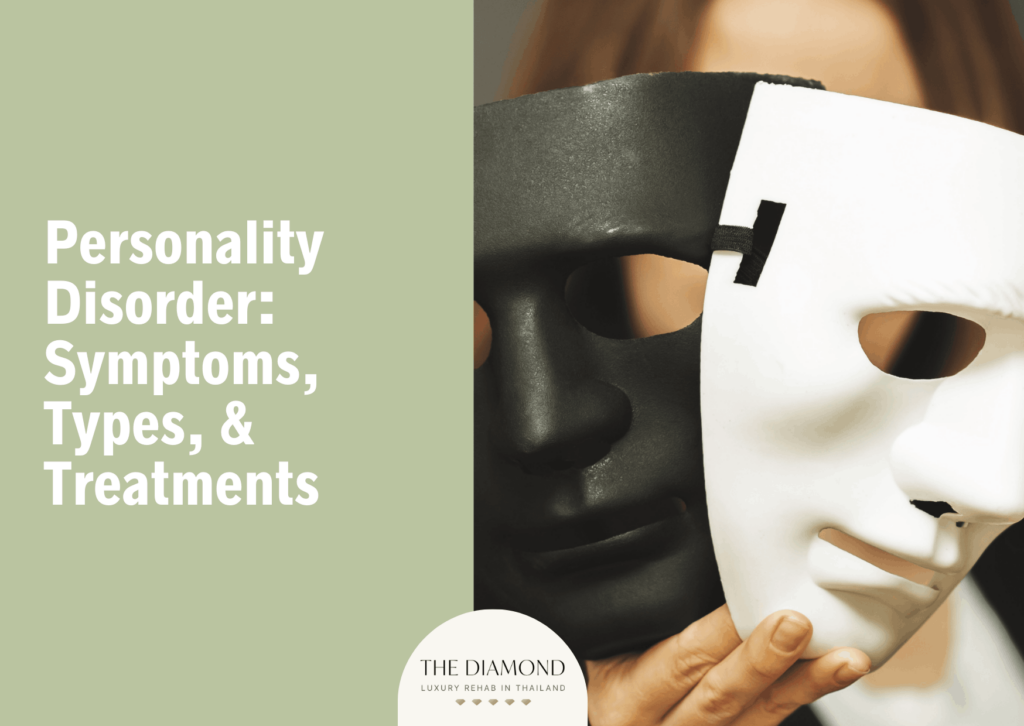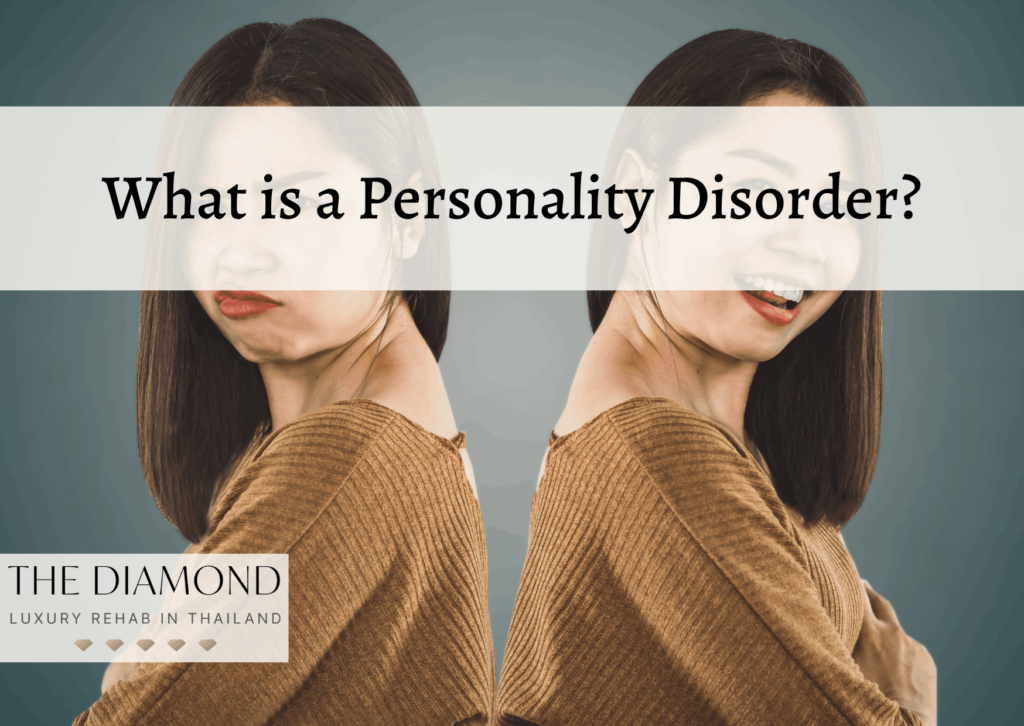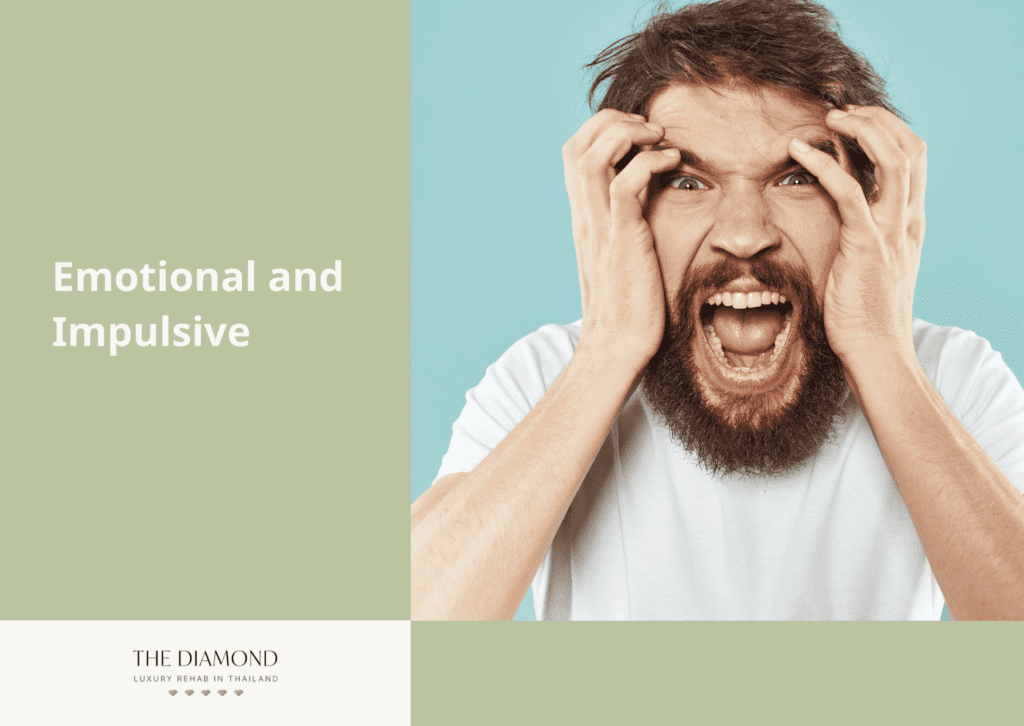Personality disorder: symptoms, types, and treatments
Table of content
- What is a Personality Disorder?
- What are the Causes of Personality Disorders?
- What are the Symptoms of Personality Disorders?

A personality disorder is a mental health disorder where patients exhibit atypical or maladaptive behavior patterns. Their feelings and thinking patterns are inflexible too. Negative or risky behaviors, feelings, and thoughts severely jeopardize functioning in different aspects of life.
Symptoms of personality disorder include being suspicious or paranoid without reason, explosive or aggressive behaviors, inflated sense of self, instant need for gratification, taking risks, and problems at school or work.
There are 10 types of personality disorders divided into three clusters – A, B, and C. Each cluster contains personality disorders that have characteristics in common.
Cluster A refers to suspicious and distrusting behaviors and includes conditions such as paranoid personality disorder, schizoid personality disorder, and schizotypal personality disorder.
Cluster B includes emotional and impulsive personality disorders. This cluster contains antisocial personality disorder, borderline personality disorder, histrionic personality disorder, and narcissistic personality disorder.
Cluster C includes personality disorders that share extreme fearfulness and anxious behaviors as characteristics. These include avoidant personality disorder, dependent personality disorder, and obsessive-compulsive personality disorder.
Treatments for personality disorders depend on the specific condition. In most cases, they are a combination of medicines and therapy (dialectical behavior therapy and cognitive-behavioral therapy).
What is a Personality Disorder?

A personality disorder is a type of mental illness indicated by long-term inflexible and atypical patterns of behaving, thinking, and feeling. A person with personality disorder experiences difficulties perceiving and relating to people and situations.
Personality disorders cause significant distress and limitations in functioning at home, work, or school, and in social situations. The scariest thing about personality disorders is that an affected person doesn’t always realize they have them. Their behavior or thinking pattern seems natural to them, so these individuals don’t think something’s wrong. For that reason, they are inclined to blame others for their limitations.
Generally speaking, personality disorders tend to begin in adolescence but persist in adulthood as well.
The history of personality disorders dates back to ancient times. The most significant development at that time was around 400 BC when Hippocrates described four patterns of personality.
These patterns were melancholic (sad), choleric (irritable), sanguine (optimistic), and phlegmatic (apathetic). Hippocrates believed that personality patterns were based on four humors such as yellow bile, black bile, phlegm, and blood. He theorized that levels of these humors determined the personality pattern of each person.
For many centuries, philosophers, physicians, and psychologists theorized about personalities and problems affecting them. However, it wasn’t until the 18th century that a person described an illness as the personality disorder we know today.
French physician, Philippe Pinel, coined the term manie sans delire (mania without delusion), which perfectly described personality disorders. Pinel described patients whose behavior was irrational even though they’ve been in touch with reality. He realized those patients had normal understanding, judgment, and perception, but at the same time, they exhibited abnormal anger as well as violence and even homicidal behaviors.
Even though literary and anecdotal descriptions of people with problems resembling personality disorders date back to ancient times, the official diagnosis of personality disorder appeared in 1952.
That year, the American Psychiatric Association published the very first edition of the Diagnostic and Statistical Manual of Mental Disorders (DSM). In DSM-1, personality disorders are described as patterns of behavior resistant to change but not associated with anxiety and personal distress on the part of the patient.
The second edition of DSM, published in 1968, described personality disorders as deeply ingrained, maladaptive patterns of behavior that differ in quality from neurotic and psychotic symptoms.
That said, DSM-3 from 1980 defined personality disorders as maladaptive and inflexible conditions that cause significant impairment in functioning. The next editions retained this description of personality disorders, but they broadened the list and diagnostic criteria.
What are the Causes of Personality Disorders?
The exact causes of personality disorders aren’t always clear. The contributing causes of personality disorders are listed below.
- Genetics: Personality traits, referred to as someone’s temperament, are passed from parents to children via inherited genes. A paper by Ted Reichborn-Kjennerud from the March 2010 issue of Dialogues in Clinical Neuroscience confirmed that certain types of personality disorders have a strong genetic component. This subject requires a lot more research, primarily to identify specific genes that play a role in the development of these disorders. It’s additionally useful to mention that certain personality traits are inherited. For example, aggression has a genetic component too.
- Environment: Relationships with family, friends, and other people, or the surroundings in which a person grows up, and events or situations they experience contribute to the development of personality disorders. A good example is childhood trauma. Experiencing or witnessing a traumatic event in childhood contributes to the development of personality disorders. This is particularly the case for persons with borderline personality disorder. Plus, children who have been exposed to verbal abuse tend to be more susceptible to developing personality disorders later in life.
What are the Symptoms of Personality Disorders?

Symptoms of personality disorders depend on the specific condition or the cluster. The most common symptoms of personality disorders are listed below.
- Strange or erratic behavior: A person with a personality disorder exhibits dramatic or emotional and erratic behaviors that others often describe as eccentric.
- Taking risks: Certain personality disorders cause higher levels of risk-taking behaviors and affective instability. A person with this mental illness tends to engage in risky behaviors.
- Suspicion or distrust: An individual with a personality disorder doesn’t trust other people and finds everything suspicious, but in most cases, there is no reason for that. Their suspicions and distrust aren’t based on concrete evidence to support these behaviors, they’re not based on logic.
- Angry outbursts: A person with this condition tends to overreact. Their intense mood swings and angry outbursts aren’t proportionate to the situation.
- Need for instant gratification: People with personality disorders get bored easily, and they have little to no tolerance for delayed gratification. For that reason, they seem impatient and self-absorbed, although that is usually not their motive.
- Problems at work/school: Impaired behaviors, attitudes, and moods limit a person’s life by causing problems at work, school, or in society in general. A person with a personality disorder tends to struggle to perform at the same level as their counterparts without a personality disorder.
How are Personality Disorders Classified?
Personality disorders are classified into three clusters based on their main characteristics. For example, cluster A contains personality disorders characterized by eccentric or odd behavior whereas cluster B includes disorders with overly emotional or unpredictable behaviors. Cluster C contains disorders characterized by fearful or anxious behaviors.
When it comes to the classification of personality disorders, it’s important to mention the revision of the World Health Organization’s International Classification of Diseases (ICD-11) which features a different approach to categorizing personality disorders.
The ICD-11 puts a strong emphasis on shared features that apply to all personality disorders. These features account for a significant portion of the general diagnostic requirements for the presence of this disorder. The ICD-11 classifies personality disorders based on their severity or personality difficulty. That’s why these conditions are classified into mild, moderate, and severe personality disorders.
There are 10 recognized personality disorders at this point. It’s useful to mention that it is possible for a person to have more than one personality disorder. For instance, individuals with a severe personality disorder meet diagnostic criteria for four, five, or more disorders.
What are the Types of Personality Disorders?
Types of personality disorders are divided into three different clusters. The types of personality disorders are listed in the table below.
| Types of personality disorders | |
| Cluster | Main characteristics |
| Cluster A | Suspicious |
| Cluster B | Emotional and impulsive |
| Cluster C | Anxious |
1. Cluster A: Suspicious

Cluster A personality disorder refers to conditions with characteristics such as being suspicious, odd, and eccentric. These behaviors lead to social problems. People with Cluster A personality disorder lack trust in others. They find something suspicious even though there’s no reason for that.
Cluster A contains three conditions such as paranoid personality disorder, schizoid personality disorder, and schizotypal personality disorder. Even though all of them are separate conditions, all personality disorders from this cluster are characterized by thinking and behavior that others find odd or eccentric.
Paranoid personality disorder (PPD) is indicated by distrustful behavior. A person with this condition is often suspicious about the motives of others and believes they want to harm them, even though the reality is different.
Since they feel threatened, people with PPD are always on guard. Other symptoms of PPD include doubting commitment and loyalty to others, being reluctant to confide in others, holding grudges, being hypersensitive, hostility, stubbornness, and argumentative behaviors.
Moreover, PPD manifests itself through difficulty relaxing, high levels of jealousy, taking innocent remarks as attacks on character, and believing they are always right.
According to an article titled, “Paranoid Personality Disorder” last updated in April 2022 by Cleveland Clinic, PPD is quite rare, affecting 0.5% to 4.5% of the U.S. population. The first signs of paranoid personality disorder occur in late adolescence or young adult years.
Schizoid personality disorder (SPD) is rare and it is characterized by avoidance of social activities and difficulties showing emotion. According to an article by Mark Zimmerman last reviewed and revised in September 2023 for MSD Manuals, the estimated prevalence of SPD ranges from 0.9% to 3.1%. It is additionally more common in people with blood relatives who have a history of schizophrenia or schizotypal personality disorder.
Individuals with SPD are often perceived as distant, humorless, and cold. They prefer to be alone, aren’t interested in close friendships (even sexual relationships), and are unable to experience pleasure from anything or express emotions.
A schizotypal personality disorder is characterized by unusual personalities. The disorder is under-recognized and understudied. The lifetime prevalence of schizotypal personality in the United States is under 4%, according to an article written by Daniel R. Rosell for UpToDate, last updated in September 2023.
A person with this personality disorder tends to have few intimate relationships, experiences social anxiety, and distrusts others. Other symptoms of schizotypal personality disorder include unusual speaking patterns and dressing style, believing in possessing special powers such as influencing others with their thoughts, and experiencing unusual sensations such as hearing voices that aren’t there.
Other symptoms of this disorder include unusual behaviors, beliefs, and mannerisms, being suspicious of others for no reason, and inappropriate reactions.
2. Cluster B: Emotional and impulsive

Cluster B personality disorder is a mental illness characterized by erratic or dramatic behavior. A person with Cluster B personality disorder tends to experience intense emotions or engage in extremely theatrical, impulsive, law-breaking, and even promiscuous behaviors.
This cluster includes antisocial personality disorder, borderline personality disorder, histrionic personality disorder, and narcissistic personality disorder.
Antisocial personality disorder tends to develop in childhood, which is quite interesting mainly because other personality disorders begin in adolescence or young adult years. Otherwise called sociopathy, an antisocial personality disorder is indicated by having no regard for right or wrong.
A person with this personality disorder ignores the rights and feelings of other people. They tend to manipulate, antagonize, and treat other people harshly. At the same time, an individual with antisocial personality disorder feels no guilt or remorse for their behavior.
According to a continuing education activity by Kristy A. Fisher and Manassa Hany last updated in 2023 for StatPearls, between 1% and 4% of people have antisocial personality disorder. The disorder is more common among men than women. It manifests itself as hostility, impulsiveness, criminal behavior, abusive relationships, failure to learn from negative consequences, and lack of empathy.
Borderline personality disorder is a condition characterized by extreme mood swings, difficulty controlling emotions (especially anger), and unstable relationships. A person with this personality disorder has a fear of abandonment and tends to exhibit impulsive and dangerous behaviors.
As a rare disorder, BPD affects around 1.4% of adults in the United States, as per a 2004 publication from the National Institute of Mental Health titled, “Personality Disorders”. It usually begins in adolescence when someone’s personality further matures. That’s why all people diagnosed with this disorder are over the age of 18.
It’s additionally useful to mention that people with BPD have unstable self-images and exhibit risky behaviors such as repeated self-harm and suicidal thoughts and tendencies. At times, temporary paranoid thoughts occur as well.
Histrionic personality disorder is indicated by unstable emotions and a distorted self-image. The term histrionic means theatrical. The self-esteem of people with this personality disorder depends on the approval of others instead of their own self-worth.
A person with HPD has a strong desire to be noticed and is likely to start behaving inappropriately just to get attention. Other symptoms of this personality disorder include feeling depressed when not in the center of attention, focusing too much on physical appearance, being gullible, believing relationships with others are closer than they are, difficulty maintaining relationships, and constantly seeking approval.
That being said, an individual with this condition isn’t aware of the problem. To them, this kind of behavior is normal. The condition usually occurs in late adolescence or early 20s and it is more prevalent in women. Less than 2% of the global population is affected by histrionic personality disorder, according to chapter 20 of the book, “Foundations of the Mind, Brain, and Behavioral Relationships” published in 2024 by the Academic Press.
Narcissistic personality disorder is a condition in which a person has an inflated sense of their importance. They crave attention and admiration, but at the same time, they lack empathy and have unhealthy relationships.
Up to 5% of people have a narcissistic personality disorder. A person with this disorder feels superior to others, is entitled, and is willing to take advantage of others to achieve their goals. Moreover, people with NPD appear arrogant and fail to consider other people’s needs. The first signs of narcissistic personality disorder appear in late adolescence or early adulthood.
3. Cluster C: Anxious

Cluster C personality disorder is characterized by anxious and fearful behaviors. Conditions that fall into this cluster are avoidant personality disorder, dependent personality disorder, and obsessive-compulsive personality disorder.
Avoidant personality disorder is indicated by chronic or persistent feelings of inadequacy and high sensitivity to being criticized or negatively judged by other people. While a person with this disorder likes to communicate or interact with others, they tend to avoid social occasions out of fear of rejection.
Individuals with this personality disorder exaggerate their potential problems or seldom try anything new. They have a poor self-image. About 2.4% of the U.S. population suffers from avoidant personality disorder, according to an article from Psychology Today titled, “Avoidant Personality Disorder” last updated in August 2021.
It affects men and women equally. Symptoms appear in childhood and cause discomfort in teenage years or young adulthood. However, the disorder is usually diagnosed in patients older than 18 years.
Dependent personality disorder is characterized by helplessness, submissiveness, and the incapability of taking care of oneself. Persons with this personality disorder struggle to make simple decisions. They tend to be pessimistic and lack self-confidence.
Other symptoms include avoidance of personal responsibility, fear of abandonment, and difficulty being alone. Less than 1% of adult people in the United States meet the diagnostic criteria for dependent personality disorder, according to an article titled, “Dependent Personality Disorder” last updated in September 2023 by Cleveland Clinic. Generally speaking, it affects more women than men.
Obsessive-compulsive personality disorder is indicated by extreme perfectionism and neatness. Symptoms of this personality disorder include difficulty expressing feelings and forming and maintaining close relationships.
People with this disorder experience anxiety that occurs with depression, face social isolation, feel righteous, and even though they’re hardworking, their obsession with perfectionism leads to inefficiency at work.
Men are twice as likely as women to develop this personality disorder. Between 2% and 7% of people have an obsessive-compulsive personality disorder, as per a 2010 study by Douglas B. Samuel and Thomas A. Widiger published in the Journal of Personality Assessment.
How Common are Personality Disorders?
Personality disorders are not as common as other mental illnesses but still affect a significant number of people. On a global level, personality disorders affect 6% of the population, while a 2020 meta-analysis by Winsper et al., published in The British Journal of Psychiatry showed that the pooled prevalence of any personality disorder is around 7.8%.
According to a 2004 article titled, “Personality Disorders” from the National Institute of Mental Health, the prevalence of any personality disorder among American adults was 9.1%. The same report explained gender and race didn’t influence the prevalence of these disorders, which is why statistical info is lacking.
However, a 2002 study by Klonsky et al., from the Journal of Personality Disorders revealed that 27% of men and around 20% of female participants met the criteria for at least one personality disorder.
When it comes to gender prevalence, it’s important to keep in mind that certain personality disorders are more common in men than others in women, while other personality disorders affect both genders almost equally.
The prevalence of personality disorders among children and adolescents ranges from 10% to 15%. It depends on the cluster and the specific condition. When it comes to the elderly, a study by Schuster et al., published in the August 2013 issue of The American Journal of Geriatric Psychiatry, 8.07% of American adults aged 65 or older met the criteria for at least one personality disorder.
How are Personality Disorders Diagnosed?

Personality disorders are diagnosed when a patient meets DSM-5 criteria. These criteria include exhibiting chronic and pervasive patterns of behavior that affect functioning, and symptoms that affect two (or more) of four areas – emotions, thoughts, impulse control, and interpersonal functioning.
The other two criteria include the onset of behavioral patterns that are traced back to early adulthood or late adolescence and patterns of behaviors that can’t be explained by other mental illnesses.
The process of diagnosing a patient, once they see a doctor and describe their symptoms, involves a physical exam as well as psychiatric evaluation. The main objective of a physical exam is to determine whether symptoms are associated with any underlying physical health problem. For this purpose, a doctor is likely to order lab tests and recommend screening for drugs or alcohol abuse.
Psychiatric evaluation usually includes a questionnaire that patients need to complete. The main point of the questionnaire is to provide more info about thoughts, feelings, and behaviors. This helps determine whether a patient meets DSM-5 criteria or not.
Diagnosing personality disorders tends to be tricky. Even when a patient meets the criteria for personality disorders, it is complicated to specify which one, especially because a number of these disorders tend to share their most prominent symptoms.
For that reason, diagnosis of personality disorders takes a while, but it is worth any patient’s time and effort because an accurate diagnosis is necessary for appropriate treatment, as per a 2023 article titled, “Personality disorders” from Mayo Clinic.
What are the Treatments for Personality Disorders?
Treatments for personality disorders depend on the specific condition, its severity, and a person’s life situation. However, treatment typically lasts months or years because personality disorders are long-standing. Multiple healthcare professionals are involved in the treatment of personality disorders, including psychiatrists, psychologists, pharmacists, psychiatric nurses, and social workers. The most common treatments for personality disorders are listed below.
- Dialectical behavior therapy
- Cognitive-behavioral therapy
- Medications
1. Dialectical Behavior Therapy
Dialectical behavior therapy (DBT) is a type of cognitive-behavioral therapy specifically developed for patients who experience their emotions intensely. In fact, the therapy was initially used to treat patients with borderline personality disorder. Today, it is used for the management of personality disorders and other mental health conditions.
In the treatment of personality disorders, dialectical behavior therapy helps because it teaches patients coping skills and strategies to deal with urges associated with suicide, self-harm, improving relationships, and regulating emotions.
The core of this therapy is to accept the current condition or situation rather than ignoring it. A patient learns to accept their personality disorder and themselves but adopt skills for positive behaviors and better functioning.
Furthermore, DBT enables patients to identify destructive behavior patterns and replace them with more positive alternatives. Additionally, patients learn to challenge their beliefs so they’re able to realize those thoughts are usually irrational.
2. Cognitive Behavioral Therapy
Cognitive-behavioral therapy (CBT) is a type of therapy that helps patients manage their problems by changing the way they think and behave. It works by teaching patients to identify negative thoughts and use coping skills to overcome them or replace those thoughts with more positive alternatives.
The core of CBT is the notion that thoughts or beliefs influence our feelings and behaviors. Certain thoughts are irrational and aren’t based on logic, but they contribute to negative feelings and lead to unhealthy, dangerous, or unwanted behavior patterns. By identifying those negative thoughts, patients are able to prevent or lessen their influence on how they feel or behave.
During cognitive behavioral therapy sessions, patients learn all techniques, skills, and other coping mechanisms that are intended to help them get better.
3. Medicines
Even though there is no FDA-approved medication specifically developed for personality disorders, doctors occasionally prescribe medicines to manage certain symptoms. For instance, a healthcare professional is likely to prescribe antidepressants for patients with depressed mood, impulsivity, anger, and irritability.
Mood stabilizers are prescribed to tackle mood swings and aggression whereas antipsychotic medications are helpful for persons with psychosis (losing touch with reality). Anti-anxiety medications are beneficial for patients with anxiety, insomnia, and agitation.
Medications aren’t a replacement for therapy. Their purpose is to reduce the intensity of symptoms a patient is experiencing.
What are the Effects of Personality Disorders Left Untreated?

The effects of personality disorders left untreated are profound and far-reaching. Effects of personality disorders left untreated are listed below.
- Dysfunctional relationships
- Impaired performance at work or school
- Social isolation
- Substance abuse
- Getting expelled from school or unemployment
- Frequent hospitalizations due to self-harm injuries
- Engaging in risky or reckless behaviors, including physical fights
- Suicide attempts
- Demoralized sense of self
Is it Possible to Prevent Personality Disorders?
No, it isn’t possible to prevent personality disorders, but it is possible to prevent certain forms of behavior or lessen their intensity. The development of personality disorders is complex, which is why there is no known way to prevent them.
When it comes to reducing the impact of personality disorders, a good example is DBT for borderline personality disorder. A 2016 paper by May et al., from The Mental Health Clinician explained that DBT reduces parasuicidal behaviors and number of hospitalizations, and increases adherence to treatment. It additionally treats comorbidities such as depression, binge eating disorder, bulimia, and substance use disorders.
Finally, a case report by Gupta et al., published in the November-December 2019 issue of the Indian Journal of Psychological Medicine demonstrated that DBT helps with emotional dysregulation and enhances social adjustment.

